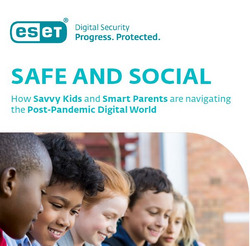The pandemic altered the way many people interact with the online world and children were no less affected by this than adults. With children home-schooling while adults worked from home, many children found their time online increasing sharply. With the line between device use for entertainment, communication and education blurring, children faced a sudden shift in how they experienced the online world.
To better understand the challenges faced online by both kids and their supervising adults, Australia’s longest-running and most trusted magazines for kids, K-Zone and Total Girl partnered with ESET to create a survey focussed on digital safety. Focussing on Australian kids aged between 6 to 13, the questions aimed to explore their online experiences and determine how the pandemic has impacted their safety and cybersecurity concerns.
The survey looked at children's experience of being online, what platforms they used and how they felt about their experiences. The survey sought to establish what was meant when kids described being “online” or using “social media”. It revealed that many children were not describing what adults might consider traditional social media platforms – the undisputed leader among ‘social’ platforms in this demographic was YouTube – and that social interactions were a major draw among popular online games.
In fact, watching video and gaming was an active part of most participant’s time online, especially in the younger groups, with more traditional social media platforms only beginning to figure among older children and early teens.
Experiences of unpleasant behaviour were fairly widespread, with 1 in 3 children reporting that they experienced nasty or hurtful acts on the internet during the past 12 months. Some trends in children’s negative experiences online emerged that overlap strongly with the rise of gaming as a significant arena in the field of online safety. Children’s concerns relating to their online gaming environments, including the fear of having their devices hacked or infected with malware, loomed larger than concerns about “mean comments” or “seeing something upsetting” which are perhaps the types of risks adults might perceive to be of greater concern.
Overall the survey shows a complex but often encouraging perspective of kids and adults managing their safety online in a post-pandemic world. Children appear to have a growing awareness of both the risks and benefits that can be found online. It also shows that the pandemic increased children’s exposure to online risks while reducing supervision, making for a potent mix of risk factors. Adults’ ideas about managing children's safety with traditional social media platforms perhaps need to be updated with awareness of the risks involved in online gaming, even for younger children.
Encouragingly, the survey also found many kids were happy in their online interactions, displayed an appropriate understanding of the dangers that could be found online and a majority felt comfortable raising issues they encountered with an adult.
For adults looking to improve how they help children enjoy the online world safely, the Safe and Social Whitepaper delves into the survey results and provides a set of recommendations for how adults and children can work together to upskill themselves on dealing with threats and bad behaviour online appropriately, so that children can continue to have positive experiences online.
Access to the full whitepaper here !
===========================================
Feel free to REGISTER to our FREE upcoming webinar - click here:
Safer Kids Online: ensuring a safe digital experience for kids
19 May @ 3:30pm AEST
Presented by:
Kelly Johnson, Country Manager @ ESET Australia
with Jake Moore, Global Cybersecurity Advisor @ ESET Global
